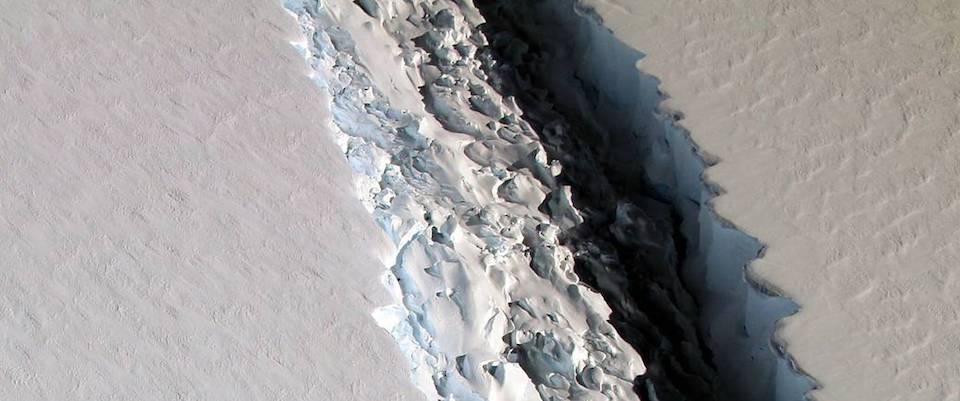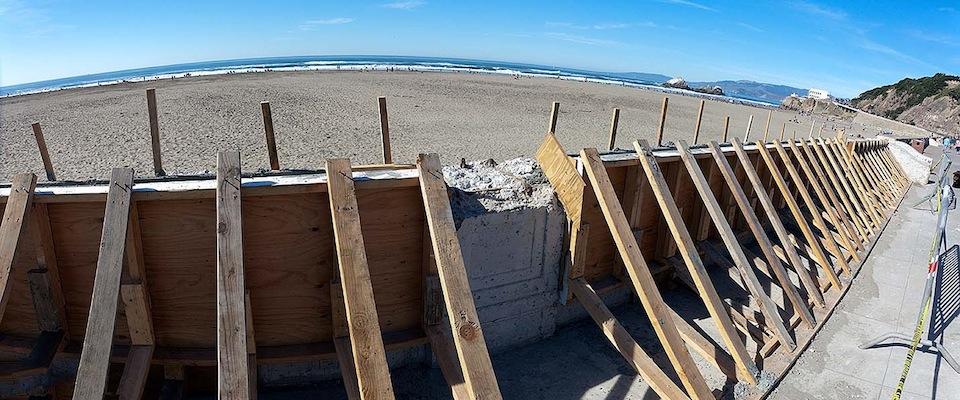The calving of an iceberg the size of Delaware from the Antarctica Peninsula’s Larsen C ice shelf made a lot of waves, raising concerns that it might directly contribute to sea level rise or portend a sudden acceleration in the melting of the continent’s gigantic ice cap. But the event pointed to neither scenario, says UC Berkeley Professor of Ocean, Earth, and Climate Science Kurt Cuffey.
“It’s drawing attention because of size, because it’s a spectacular event, but it was already floating on the ocean when it broke off,” says Cuffey. “That means it won’t directly contribute to sea level rise. If it had been anchored on land or the sea bottom, then some degree of sea level rise could be possible.”
Also, says Cuffey, a floating ice shelf breaking off at its leading edge, as was the case here, doesn’t change the rate of the downward flow of glacial ice located above the break. A significant shearing of ice anchored to land, however, would result in some degree of sea level rise, and could also result in the rapid movement of huge quantities of “upstream” glacial ice into the ocean; it would be analogous to a dam breaking.
But while the calving of the trillion ton berg will have no direct impact on sea levels, it still says profound things about climate change, Cuffey says.
With Larsen A and B, says Cuffey, temperatures became so high that there was a great deal of melt water on the surface of each shelf.
“The reason this is extremely interesting is because there already have been big ice shelves—specifically Larsen A and Larsen B—that have been destroyed by global warming,” Cuffey says. “Both are in the same region as Larsen C, but farther north [where temperatures typically are warmer than more southern portions of Antarctica]. And both incidents happened in January, typically Antarctica’s warmest month.”
With Larsen A and B, says Cuffey, temperatures became so high that there was a great deal of melt water on the surface of each shelf.
“This [melting of Larsen A and B] was occurring in areas where no significant surface melt had previously been noted,” Cuffey says. “As the surfaces melted, it drove fractures deep into each ice shelf, and that allowed extremely large sections to disintegrate completely. For both Larsen A and B, we essentially went from an ice shelf to ice cubes in a matter of months.”
Such destruction of Antarctica’s ice shelves was postulated long ago. In 1978, Ohio State University glaciologist John Mercer published a paper in Nature predicting that climate change could cause the rapid collapse of much of the West Antarctic ice sheet.
“It was a brilliant paper,” says Cuffey. “Mercer suggested that as summer temperatures in Antarctica increase, ice shelves will start to disintegrate, starting in the north and proceeding south. That’s exactly what happened with Larsen A [in 1995] and B [in 2002]. That’s why Larsen C is so interesting: it’s the next domino in line. It’s likely we’ll see the destruction of Larsen C in the not too terribly distant future. And when it happens, it won’t be from large icebergs calving from the leading edge. It’ll be the surface melt water and ice cube scenario.”
Geophysical impacts will really start accumulating, says Cuffey, when the big ice sheets in the more southern portions of the continent—most notably, the Ross Ice Sheet—begin disintegrating.
A massive ice sheet collapse in Antarctica would cause sea levels to climb by five meters or more, “and you’d say goodbye to Miami, London, much of Bangladesh, and the Netherlands.”
“Much of that is grounded, not floating ice, meaning destruction will cause dramatic sea level rise,” says Cuffey. “That will happen when summertime temperatures in Antarctica reach five degrees C, a level that corresponds to a global temperature increase of two to three degrees C. [Temperatures at the poles are amplified as global net temperatures rise.]
A massive ice sheet collapse in Antarctica would cause sea levels to climb by five meters or more, “and you’d say goodbye to Miami, London, much of Bangladesh, and the Netherlands,” says Cuffey. “As things stand now, we could expect to see that in about a hundred years.”
That’s not long in geologic, or even human, time scales. So should Miami get ready to pack up and move to Atlanta? Carbon emissions, after all, continue to rise, hitting record levels in 2015 and 2016, and the Trump administration’s recent abandonment of the Paris climate agreement hardly bodes well for short term progress.
“It’s not completely hopeless,” says Cuffey. “Right now, global temperatures have risen about one degree C [since the Industrial Revolution], so we’re about one-third to half way there. If we got serious about reducing carbon emissions, we might avoid that five degree threshold in Antarctica.”





















